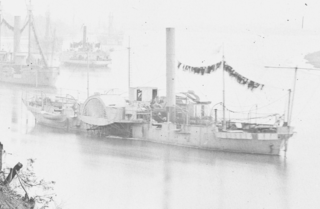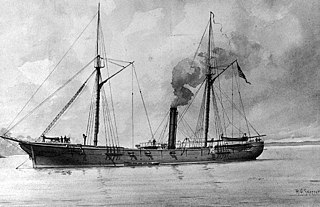
USS Katahdin was a Unadilla-class gunboat built for the U.S. Navy during the American Civil War.
USS A. Houghton – a 326 ton bark – was purchased during the beginning of the American Civil War by the Union Navy.

The first USS Miami was a side-wheel steamer, double-ender gunboat in the United States Navy during the American Civil War.

USS Richmond was a wooden steam sloop in the United States Navy during the American Civil War.

The first USS Cayuga was a Unadilla-class gunboat in the United States Navy.

USS Sciota was a Unadilla-class gunboat built on behalf of the United States Navy for service during the Civil War. She was outfitted as a gunboat, with both a 20-pounder rifle for horizontal firing, and two howitzers for shore bombardment, and assigned to the Union blockade of the waterways of the Confederate States of America.
USS Henry Janes was a mortar schooner acquired by the United States Navy during the American Civil War. She was used as a gunboat and assigned to the blockade of ports of the Confederate States of America.
The second United States Navy vessel to bear the name, USS Sachem was a screw steamer built in 1844 at New York City, where the U.S. Navy purchased her on 20 September 1861.
USS Rachel Seaman was a wooden schooner purchased by the Union Navy during the American Civil War.
USS Horace Beals was a barkentine acquired by the Union Navy during the American Civil War. She was placed into service as a cargo ship assigned to support the fleet blockading the ports of the Confederate States of America. However, at times, Horace Beals was assigned extra tasks, such as that of a hospital ship as well as an ammunition ship.
USS Sarah Bruen was a wooden schooner acquired by the United States Navy during the beginning of the American Civil War.

USS Winona was a Unadilla-class gunboat built for service with the Union Navy during the American Civil War. Winona was heavily armed, with large guns for duels at sea, and 24-pounder howitzers for shore bombardment. Winona saw significant action in the Gulf of Mexico and in the waterways of the Mississippi River and was fortunate to return home safely after the war for decommissioning.

USS Racer was a schooner acquired by the Union Navy during the American Civil War. She was used for various purposes, but, especially for bombardment because of her large 13-inch mortar that could fire up and over tall riverbanks.
USS Massachusetts was a large steamer acquired by the U.S. Navy prior to the American Civil War.
USS Sea Foam was a brig purchased by the Union Navy during the American Civil War.
USS George Mangham was a schooner acquired by the Union Navy during the American Civil War. She was used by the Union Navy as a gunboat in support of the Union Navy blockade of Confederate waterways.

USS Antona was a steamer captured by the Union Navy during the American Civil War. She was used by the Union Navy as a dispatch boat and gunboat in support of the Union Navy blockade of the Confederate States of America.
USS Arletta was a schooner acquired by the Union Navy during the American Civil War. She was used by the Union Navy as a gunboat and, at times, an ammunition ship, in support of the Union Navy blockade of Confederate waterways.
USS Norfolk Packet was a large schooner purchased by the Union Navy during the American Civil War. She was assigned to gunboat duty in the inland waterways of the Confederate States of America.
USS T. A. Ward was a 284-ton schooner was purchased by the Union Navy during the Union blockade of the Confederate States of America during the American Civil War.







